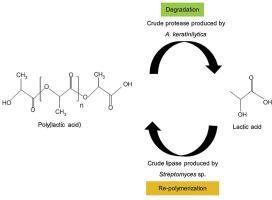Polymer ( IF 4.1 ) Pub Date : 2020-07-24 , DOI: 10.1016/j.polymer.2020.122812 Titiporn Panyachanakul , Thanasak Lomthong , Wanlapa Lorliam , Jaran Prajanbarn , Shinji Tokuyama , Vichien Kitpreechavanich , Sukhumaporn Krajangsang

|
Poly (lactic acid) (PLA) is a biodegradable plastic that has received considerable attention since it plays an important role in replacing commercial plastics and resolving the global warming problem. Recently, biological degradation and polymerization studies of PLA have been an active topic. Microbial solvent-tolerant and thermostable lipases are interesting since they have the potential to induce PLA polymerization. The aims of this study are to isolate solvent-tolerant and thermostable lipase-producing actinomycetes and to apply the crude enzyme produced by an isolated strain for PLA polymerization. According to the results, the best solvent-tolerant and thermostable lipase-producing actinomycete was strain A3301, with a lipase activity of 108 U/ml in the production medium. The crude enzyme produced by strain A3301 demonstrated the optimum temperature and thermostability at 60 °C and 45–55 °C, respectively. Moreover, the enzyme showed the ability to tolerate 10–20% (v/v) hexane and toluene. Strain A3301 was identified as Streptomyces sp. by using the 16S rDNA sequence. A thermo-solvent-tolerant lipase from this strain was used in PLA polymerization experiments. The optimal conditions for PLA synthesis were 60 °C for 8 h, using dried lipase at a concentration of 10% (w/v) and a fixed lactic acid concentration of 450 g/L under a nitrogen atmosphere. The highest molecular weight of the PLA product was 525 Da, and the degree of polymerization was approximately 7. Subsequently, the repolymerization process of PLA using this enzyme was investigated. The maximum molecular weight of the PLA product was 577 Da, and the degree of polymerization was approximately 8.
中文翻译:

链霉菌属产生的耐热溶剂脂肪酶的新见解。A3301,用于聚(dl-乳酸)的再聚合
聚乳酸(PLA)是一种可生物降解的塑料,备受关注,因为它在替代商业塑料和解决全球变暖问题中发挥着重要作用。近年来,PLA的生物降解和聚合研究一直是一个活跃的话题。耐微生物和热稳定的脂肪酶很有趣,因为它们具有诱导PLA聚合的潜力。这项研究的目的是分离耐溶剂和热稳定的产生脂肪酶的放线菌,并将分离出的菌株产生的粗酶用于PLA聚合。根据结果,最佳的耐溶剂和热稳定的产生脂肪酶的放线菌是菌株A3301,在生产培养基中的脂肪酶活性为108 U / ml。由菌株A3301产生的粗酶分别在60°C和45-55°C下显示出最佳的温度和热稳定性。此外,该酶显示出能够耐受10–20%(v / v)的己烷和甲苯的能力。菌株A3301被确定为链霉菌属 通过使用16S rDNA序列。来自该菌株的耐热溶剂脂肪酶用于PLA聚合实验中。在氮气气氛下,使用浓度为10%(w / v)的干燥脂肪酶和固定的乳酸浓度为450 g / L的PLA合成的最佳条件是60°C 8 h。PLA产物的最高分子量为525 Da,聚合度约为7。随后,研究了使用该酶的PLA的再聚合过程。PLA产物的最大分子量为577 Da,聚合度约为8。











































 京公网安备 11010802027423号
京公网安备 11010802027423号